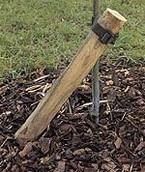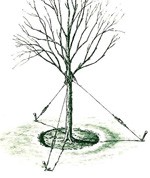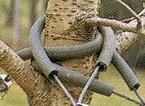When planted right and in the right spot, maples are one of the easiest and long-lived trees you'll ever grow.
Here's a breakdown of what you need to know...
Please Note: If you are planting a Japanese Maple tree follow these links for planting instructions...
Cultural Preferences
Soil
Most maple trees are adaptable to many soil types, including clay. They prefer a well-drained but moist soil of average fertility. Though some maple varieties will grow in swamps, other will handle periods of wet soil due to heavy rainfall but constantly wet soil could be problematic. It's good to know the moisture needs of the specific maple variety you intend on planting. You'll find soil type and moisture preferences on every plant page in the Wilson Bros Gardens website.
How To Test Soil Drainage
If you are uncertain about soil drainage in the area you intend to plant your maple, it's well worth taking the time to test the drainage. To test soil drainage, dig a hole 12" wide by 12" deep in the planting area. Fill the hole with water and let it drain. Then, after it drains, fill it with water again, but this time clock how long it takes to drain. In well-drained soil the water level will go down at a rate of about 1 inch an hour. A faster rate, such as in loose, sandy soil, may signal potentially dry site conditions. A slower rate indicates poor draining soil and is a caution you might need to improve drainage, plant in a raised mound or bed, or look for trees that are more tolerant of wet or boggy conditions, such as river birch.
Soil pH
Maple trees grow best in an acid to neutral soil ranging from 5.0 to 7.0 on the pH scale. Most average garden soils fall between a pH range of 6.0 to 7.0.
Testing Soil pH
Soil pH is a measurement of the alkalinity or acidity of soil and is measured on a scale of 1-14, with 7 as the neutral mark. Any measurement below 7 indicates acid soil conditions, and anything above 7 indicates alkaline. If you're unsure about the pH of your soil, or whether or not it's suitable for growing maple trees, it's a good idea to test the soil pH in the planting area. You can quickly test soil pH with an inexpensive soil pH tester probe. To raise the pH (make more alkaline) you can add pelletized limestone to the soil. To lower the pH (make more acid) you can apply Soil Sulfur, Aluminum Sulfate, or Chelated Iron. Adding organic compost to the soil or using compost as mulch can also help to increase acidity and maintain acid soil conditions.
Learn More: What is Soil pH and How To Adjust It?
Light Needs
Maple trees grow best in full sun however will tolerate a fair amount of shade. branching and foliage will be more dense with more sun.
Planting A Maple Tree In The Ground
Scroll down for container planting instructions
TIP: Before planting, it's beneficial to water the root ball deeply before removing your Maple tree from its container.
Step 1
Start by digging your planting hole at least three times as wide and as deep or not much deeper than the root ball of your maple tree. The wider the hole the better. Place native soil removed from planting hole around the perimeter of the hole, in a wheel barrow, or on a tarp.
Step 2
Depending on the type, fertility and porosity of the soil in the planting area, it may be beneficial to amend the native soil. When planting in dense clay or other compacted soils it is beneficial to thoroughly mix in some bagged top soil or a good planting mix at a 25 to 50% ratio with the native soil removed from the planting hole. When planting in very sandy, quick-draining soil consider mixing in some top soil, peat moss and/or compost to help retain moisture. When planting in well-drained but moist soil of average fertility there is no need for adding a soil amendment.
Step 3
To remove your maple tree from the nursery container it was growing in, firmly grasp the base of its trunk and try to gently lift and remove it from its container. If the root ball is stuck in the container either cut the container away or place the tree on it's side and tap on the side of the container to loosen the root ball. After having removed your tree from the container, use your fingers or a claw tool to loosen some feeder roots around the surface of the root ball. If root bound, you can spray the sides and bottom of the root ball with a stream of water from a garden hose. This will help to wash away some soil from the exterior of the root ball making it easier to loosen roots.
Step 4
If you are planting in well-drained soil set your maple tree in the planting hole so that the top edge of the rootball is at or slightly above ground level. If necessary, add some backfill soil mixture to the bottom of the hole to achieve proper planting height.
Note: If the soil is poorly drained (constantly soggy or wet), and you are planting a maple variety that prefers well-drained soil, either improve drainage, plant the root ball in a raised mound entirely above ground level, or select a different tree species more tolerant of wet soils, such as river birch.

Step 5
After setting your maple tree in the planting hole, use one hand to hold the tree straight and your other hand to begin back-filling your soil mixture around the root ball, tamping as you go to remove air pockets. When you have filled the hole to the halfway point you can soak the soil. Then continue back-filling to the top edge of the root ball. If you are planting higher than ground level taper your soil mixture gradually from the top edge of the root ball to the ground level. To avoid suffocating your tree, avoid placing any soil on top of the root ball. You can place mulch on top of the root ball later.
Step 6 (Optional)
When planting a maple tree in a location that is far from a water source, and that has well-drained soil, you can use remaining soil mixture to build a water retaining berm (catch basin) around the outside perimeter of the planting hole. This basin will help to collect water from rainfall and irrigation often reducing the need for hand-watering. The berm can be removed after a year or so when your tree has established itself.
Step 7
Next, deeply water the planting area, including the root ball, to a depth equal to the height of the root ball. For an extra boost, to stimulate early root formation and stronger root development, you can also water you newly planted maple tree with a solution of Root Stimulator, which reduces transplant shock and promotes greener, more vigorous trees.
Step 8
To conserve moisture and to suppress weed growth, apply a 2" layer of cured, shredded or chipped wood mulch or pine straw around the planting area. As the mulch decomposes it will add vital nutrients to the soil that your tree will appreciate. Avoid the use of freshly chipped or shredded wood for mulch until it has cured in a pile for at least 6 months, a year is better. Avoid placing or piling mulch directly against the base of your tree as doing so could cause the bark to rot.
Planting A Maple Tree In A Pot
First, most maple trees grow too large to grow in pots indefinitely. That said, you can enjoy growing them in large containers and planters while young and then transplant them later to the landscape.
Maple trees growing in pots appreciate a moist but well-drained soil. Constantly soggy or wet soil can and often will cause root rot or other harmful or deadly plant diseases. Therefore, choose a container with a drainage hole(s) and a quality potting soil or potting mix, or a 50/50 combination thereof, which holds moisture evenly but drains well. You can also add about 10 to 20% pumice or perlite to the soil mixture to help with drainage.
Make sure to choose a container with drainage holes at the bottom and one that is large enough to allow for 2 to 3 years of growth before having to shift up to a larger size container or transplant your tree to the landscape. This might mean your planting pot would be 10-12 inches or more in width than the root ball of your maple tree.
Note: Keep in mind the wind. When planting taller growing trees in containers, wind is always a factor. Choose a pot with a low profile and make sure to place your container where it will not be exposed to high winds. Sqaure pots tend to be more stable than round pots. You can also place a brick(s) or other heavy objects in the bottom of the container to help stabilize it.
Container color will matter as well. Not only will you want to pick a container color that goes well with the foliage color(s) of your maple tree, you'll also want to pick a container that matches the style of your home or other structures and other plants in the surrounding environment.
Many nursery & garden centers offer a wide variety of containers to choose from. Before heading out to buy a container take pictures of your home and the surrounding environment. Doing so will help you to choose just the right color and style.
Container Planting Instructions
Step 1
Before filling your container with the soil mix, we recommend lining the bottom with shade cloth or a porous landscape fabric. This will keep the drain holes from becoming stopped up with soil. If you choose to use stone in the bottom of the pot, lay the fabric over it.
Step 2
To remove your maple tree from the nursery container it was growing in, firmly grasp the base of its trunk and try to gently lift and remove it from its container. If the root ball is stuck in the container either cut the container away or place the tree on it's side and tap on the side of the container to loosen the root ball. After having removed your tree from the container, use your fingers or a claw tool to loosen some feeder roots around the surface of the root ball. If root bound, you can spray the sides and bottom of the root ball with a stream of water from a garden hose. This will help to wash away some soil from the exterior of the root ball making it easier to loosen roots.
Step 3
Pour a small amount of your soil mixture in the bottom of the container. Set your tree in the container and make necessary adjustments by adding or removing some soil so that the top edge of the root ball will sit 2 inches or so below the rim of the container.

Step 4
Backfill with your potting soil around root ball, tamping as you go, until the level of potting soil is even with the top edge of root ball.
Step 5
Water thoroughly until water starts to drain from the holes in the bottom of the container. Add more potting mix if settling occurs during watering.
Step 6 (Optional)
Apply a 1" layer of wood chips or sphagnum moss to soil surface to help conserve moisture. You can also incorporate low growing, spreading plants in your container planting that will serve as a permanent soil cover.
Staking a Newly Planted Maple Tree

Single Stake Method
For smaller trees, use one long stake driven firmly into the ground so that it crosses the trunk of the tree at an angle a foot or two above the ground (depending on height of tree). Use a piece of cloth or a section of rubber water hose to tie trunk loosely against the stake. Loop the cloth around the trunk of the tree and then cross the ends over one another before looping and tying it around the stake. Doing so help to keep the tree trunk from rubbing against the stake in windy weather. Avoid using metal wire as a tie as it can cut into the bark of your tree.

Triple Stake Method
For taller trees, you can drive three 18" long stakes at a 45 degree angle into the ground beyond the outside perimeter of the planting hole. Space the stakes evenly around the planting hole. Use wire or nylon string to tie from the stake to the tree. To protect the bark of your tree, make sure to run the string or wire through rubber hosing where it will come into contact with the trunk or branches. More on this just below.

To ensure your string or wires do not slide down the trunk of your tree, when tying your string or wire to the tree, you will need to tie above a branch. Otherwise your wires will slide down the trunk. To prevent damage to the bark of your tree, rubber hosepipe should be used where the wire touches the stem or branches.

